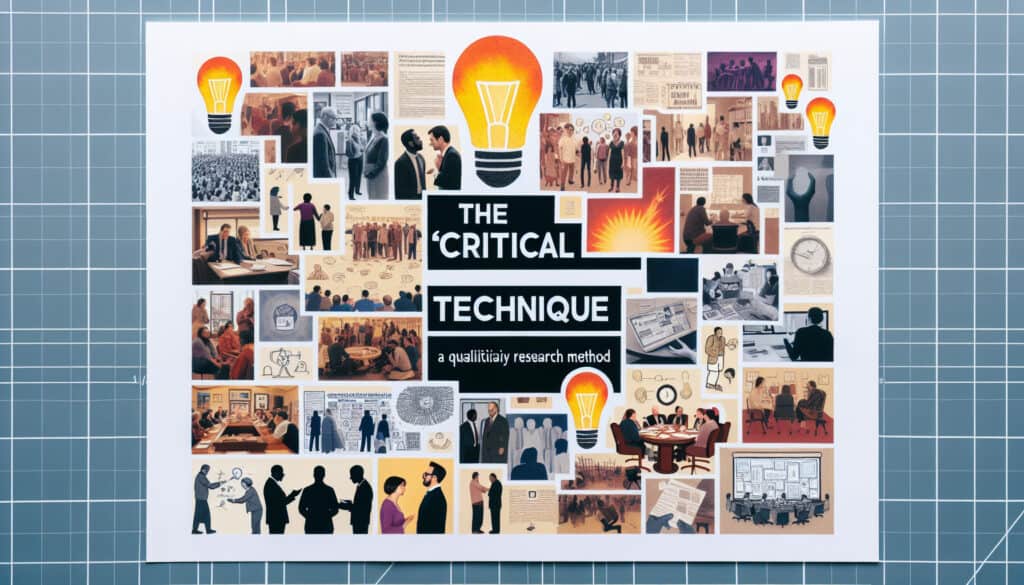A qualitative research method that involves collecting detailed information about significant real-world events (incidents) from observers or participants.
- Methodologies: Customers & Marketing, Ideation, Product Design
Critical Incident Technique

Critical Incident Technique
- Continuous Improvement, Design for Six Sigma (DfSS), Design Thinking, Human-Computer Interaction, Quality Management, Usability, Usability Testing, User experience (UX), User-Centered Design
Objective:
How it’s used:
- Interviewers ask users or employees to describe specific instances where they experienced a particularly positive or negative outcome while performing a task, along with the context and consequences.
Pros
- Gathers rich, contextualized data about real-world user behaviors and problems; helps identify key factors that lead to success or failure; provides specific examples for design or training improvements.
Cons
- Relies on participants' memory, which can be inaccurate or biased; incidents may be rare and not representative of typical use; analysis of qualitative data can be time-consuming.
Categories:
- Ergonomics, Human Resources, Product Design, Quality
Best for:
- Understanding the key factors that contribute to successful or unsuccessful outcomes in a user's interaction with a system.
The Critical Incident Technique (CIT) is particularly adaptable in user experience research, usability testing, and workplace productivity evaluations across various sectors, including healthcare, education, software development, and customer service. The methodology is often employed during early project phases to inform design decisions or during iterative testing stages to refine existing systems. Typically, the initiation of CIT can be spearheaded by user experience researchers, product designers, or human factors engineers who seek to gather detailed qualitative data directly from users or employees. Participants in this methodology are primarily users of the product or system in question, as well as employees who interact with the process, offering authentic insights into their experiences. An example application in the healthcare sector could involve interviewing nurses about critical incidents they encountered while using Electronic Health Record (EHR) systems, which can reveal pivotal factors that either enhance or undermine patient care due to usability issues. By documenting both positive and negative incidents, teams can establish a clear understanding of systemic barriers and successful strategies that lead to improved user interactions, thus laying a foundation for targeted design improvements and training initiatives. The real-world rich data achieved through CIT allows organizations to make informed decisions grounded in actual user experiences rather than assumptions or generalized feedback.
Key steps of this methodology
- Identify specific tasks or interactions to investigate.
- Prompt users or employees to recall significant incidents related to those tasks.
- Encourage elaboration on the context of each incident.
- Ask for details about the outcomes and consequences of the incidents.
- Explore the user's feelings and thoughts during the incident.
- Request clarification on what contributed to the success or failure in the situation.
- Analyze the collected incidents for common themes and patterns.
- Prioritize identified factors based on their impact on user experience.
Pro Tips
- Leverage follow-up probing questions to delve deeper into the emotional and situational context of reported incidents, enriching the understanding of user motivations and reactions.
- Utilize thematic analysis on collected incidents to uncover underlying patterns and trends that can inform both design choices and training interventions.
- Incorporate multi-modal data sources (e.g., observational data, task analysis) alongside incident interviews to validate findings and uncover discrepancies between perceived and actual user experiences.
To read and compare several methodologies, we recommend the
> Extensive Methodologies Repository <
together with the 400+ other methodologies.
Your comments on this methodology or additional info are welcome on the comment section below ↓ , so as any engineering-related ideas or links.
Historical Context
1962
1970
1972
1980
1980
1986
1986
1960
1963
1970
1980
1980
1980
1986
1987
(if date is unknown or not relevant, e.g. "fluid mechanics", a rounded estimation of its notable emergence is provided)















Related Posts
Musculoskeletal Discomfort Questionnaires
Multivariate Testing (MVT)
Multiple Regression Analysis
Motion Capture Systems
MoSCoW Method
Mood’s Median Test